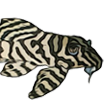I'm looking at the photos of and I think they're all mis-ID'd.
Here's the image, diagnostics, and part of the verbal narrative from the original description:
Diagnosis. Readily distinguished from all known pimelodids by flexible, unbranched first ray and ten branched rays of its dorsal fin. Dorsal fin situated relatively far posteriorly; pterygiophore of anterior dorsal-fin ray articuating with neural spine of tenth vertebra. Blade-like neural spines of vertebrae five through nine extend dorsally, diverging at their dorsal ends to form a double row of ossifications just ventral to skin between supraoccipital and dorsal-fin origin (Fig. 2a, b); a slender supraneural at posterior end of this v-shaped predorsal trough has attached muscles extending anteriorly between bifid neural spines to supra- occipital. Distinguished from other ten or eleven species currently classified as Cetopsorhamdia (Gosline, 1941, 1945; Schultz, 1944:218-220; Schubart and Gomes, 1959) by maxillary barbel very long, reaching posteriorly beyond anal-fin base (versus reaching posteriorly at most to pelvic-fin origin in other species of Cetopsorhamdia), and by its distinctive pigmentation pattern described in detail below (Fig. 1).
Most obviously, the dorsal fin has too few dorsal rays, and the maxillary barbels are far too short, but additionally the color pattern doesn't match. This species color pattern is divided between front half of body and back. The photos we have divide the body dorsal to ventral.When alive, coloration very much like that of preserved specimens (Fig. 1) with one striking exception-head and body anterior to line be- tween dorsal- and pelvic-fin origins beautiful, irridescent green. Live specimens from depths of turbid Rio Aguarico differ in having head and anterior body metallic gold with a green sheen and similar coloration on entire caudal peduncle, but one Rio Aguarico specimen with dark caudal peduncle like specimens from Rio Jivino.
Snout, lips and chin anterior to mental barbels very dark with what appear to be numerous sensory papillae forming gray speckles on darker background. Similar papillae cover sides and top of head, and back to dorsal-fin origin; papillae scarce or absent over elongate occipital fontanel. Two ovate, light-colored spots on nape bracketing occipital process; thus, contrasting with more typical Cetopsorhamdia condition of light band extending entirely across nape. Belly and underside of head posterior to mental barbels dusky gray, becoming progressively darker posteriorly towards pelvic-fin origin. Mental barbels gray and maxillary barbels darker, approximately matching their corresponding backgrounds. Body anterior to dorsal- and pelvic-fin origins olive-gray, slightly darker towards back. Remainder of body (except caudal peduncle of Rio Aguarico specimens), caudal- fin base, and much of dorsal, adipose, and anal fins very dark, almost black, contrasting sharply with almost unpigmented distal portions of those same fins. Caudal, pectoral, and pelvic fins of holotype relatively clear with two narrow, transverse bands formed by dark chromatophores concentrated on rays; similar submarginal band present on anal fin. Dark pigment on pectoral, pelvic and anal fin of paratype and nontypes more irregular, blotchy.
I think these photos are more likely either Cetopsorhamdia hidalgoi, or possibly an undescribed species, since the narrative of C. hidalgoi doesn't include a distinct color difference between dorsal and ventral parts of the body (that said, C. hidalgoi was described from museum specimens, so color may have changed).
We just caught some fish near Iquitos that look similar to the fish in our photos for C. phantasia. The colors are truly lovely. Unfortunately I'm not able to share pics yet, because we caught the fish with the help of a local fisherman who took us to a special place that only he fishes. We promised not to release photos or locality data unless we publish something formally.
My question is, what do you know of the provinence of these photos uploaded as C. phantasia? Where shall I move the photos on C. phantasia? Should I create a new CLOG page called Cetopsorhamdia cf. hidalgoi? Or Cetopsorhamdia sp.(#)? If we know where they were collected, maybe they could be C sp. Peru(2), but I don't know their origin.
Thanks in advance,
Eric





